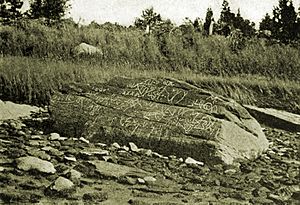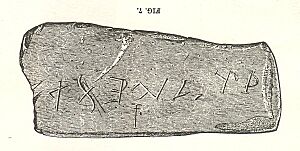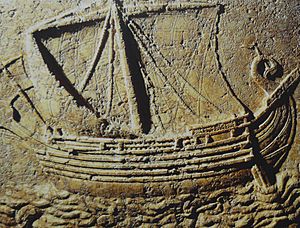Theory of Phoenician discovery of the Americas facts for kids
The theory of Phoenician discovery of the Americas suggests that ancient Phoenicians, or other similar groups, might have reached the Americas long before Christopher Columbus or the Norse settlers. This idea focuses on the first thousand years before Christ was born.
Contents
Early Ideas and Speculation
Ancient Sea Stories
Some people think that ancient sailors might have known about the Sargasso Sea. This is a large area in the Atlantic Ocean known for its seaweed. A writer from the late 300s AD, Rufus Festus Avienius, wrote a poem about this. He said his information came from a lost story by a Carthaginian sailor named Himilco from the 400s BC.
Mysterious Rock Carvings

In the late 1700s, people wondered about the carvings on Dighton Rock in Massachusetts. Ezra Stiles, who was the president of Yale University, thought they were written in Hebrew. Another person, Antoine Court de Gébelin, believed the carvings showed that sailors from Carthage (which is now Tunisia) visited the East Coast a long time ago.
Mormon Beliefs
In the 1800s, some people who followed Mormonism believed that ancient Israelites visited the Americas. Ross T. Christensen suggested that a group called the Mulekites in the Book of Mormon might have been mostly Phoenician.
Why Some People Disagreed
Not everyone believed in these early visits. John Denison Baldwin, in his 1871 book Ancient America, argued against the idea of Phoenician visits. He said that if Phoenicians had come to America, they would have built things differently. Their language and writing would also have been very different from what was found in ancient American ruins. He pointed out that the writing in places like Palenque and Copan looked nothing like Phoenician writing.
Possible Ancient Objects
The Paraíba Inscription
In 1872, a stone with Phoenician writing was supposedly found in Paraíba, Brazil. The writing told a story about a Phoenician ship. It said the ship was separated from its fleet by a storm while sailing from Egypt around Africa. It also mentioned an ancient Egyptian pharaoh.
A copy of the writing was shown to Ladislau de Souza Mello Netto, who was the director of the National Museum of Brazil. At first, he thought it was real. But by 1873, a language expert named Ernest Renan convinced him it was a fake. The letters on the stone seemed to come from different time periods, spanning 800 years. This made it seem unlikely to be real. No one ever saw the actual stone, and its source was never found.
In the 1960s, Cyrus H. Gordon translated the text again and thought it was real. He said it didn't copy any Semitic writing that was widely known back then. However, another expert, Frank Moore Cross, disagreed. He said that everything in the inscription could have been found by a forger in books from the 1800s.
Other Disputed Finds

Cyrus H. Gordon also believed that ancient Hebrew writings were found in the southeastern United States. He thought this meant Jewish people arrived there before Christopher Columbus. One such find was the Bat Creek inscription. Gordon thought it was Phoenician, but most experts now believe it is a fake. Another object, the Los Lunas Decalogue Stone, has also been said to support the idea of Semitic people discovering the Americas. However, it is also widely believed to be a fake.
Newer Theories
Modern Supporters
In the 1900s, people like Cyrus H. Gordon, John Philip Cohane, Ross T. Christensen, Barry Fell, and Mark McMenamin continued to support the idea of ancient visits.
The Coin Map Idea
In 1996, Mark McMenamin suggested that Phoenician sailors discovered the New World around 350 BC. He looked at gold coins made by the Phoenician state of Carthage from that time. He thought a pattern on the back of these coins looked like a map. He believed it showed the Mediterranean Sea with the Americas to the west across the Atlantic Ocean. McMenamin still believes this idea today (2021).
Ptolemy's Geography
Lucio Russo has also thought about Phoenicians possibly reaching the Americas. He studied Ptolemy's book Geography. In this book, Ptolemy gives coordinates for the Fortunate Isles. But Ptolemy also made the world seem one-third smaller than it actually is. Russo noticed that if you think Ptolemy's "Fortunate Isles" were actually the Antilles (islands in the Caribbean), then the world's size makes sense. Also, other strange parts of Ptolemy's world map fit better. Russo thinks that Ptolemy's source, Hipparchus, knew about the Antilles. Hipparchus lived in Rhodes and might have gotten this information from Phoenician sailors. This is because Phoenicians controlled the western Mediterranean at that time.
What Experts Say Today
Marshall B. McKusick, a professor of anthropology, has looked at many theories about Phoenicians or Canaanites in the New World. He has dismissed them, saying that people often want to believe their own ideas.
Glenn Markoe says that it will "probably never be known" if the Phoenicians ever reached the Americas. He explains that proof like the Paraíba inscription is unlikely to be real, as it was a clever fake. He thinks that if such a trip had happened, we would more likely find small pieces of Phoenician pottery.
Ronald H. Fritze has studied the history of these claims from the 1600s to the 1900s. He concludes that while it's technically possible, there is no archaeological evidence to prove it. He points out that even the short visit by the Norse to Vinland left clear archaeological remains in Newfoundland. So, if the Phoenicians had a larger presence, they should have left similar evidence. The lack of such evidence suggests they never reached the Americas.
See also
 In Spanish: Teoría del descubrimiento fenicio de América para niños
In Spanish: Teoría del descubrimiento fenicio de América para niños


